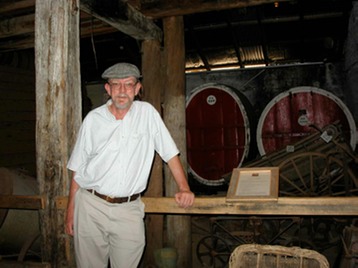Friday, 19 June 2009
Knowing the place was on the market tipped me over the edge when the invitation to join the Baileys of Glenrowan 1870 Club arrived in the mail, or, more accurately, that knowledge combined with long-held affection for the winery and its products, though they’re not too thick on the ground in my part of the world.

From the earliest days of Hughesy’s interest in Australian wine there have been a couple of items that it took me quite a few years to cross off the must do/taste/visit list. One was Lake’s Folly, which got crossed off fairly early on in the tasting department, thanks to the Lighthouse Keeper’s Daughter, and was finally visited in late 2005 on our visit to the Hunter. And I’ve got the photo to prove it...
It took me years to catch up with Tahbilk Marsanne, but further along the Hume Highway Hughesy’s first vineyard visits took place way back in January 1980 when a mate and I made our way around Rutherglen and ended the tasting tour at Baileys.
The pursuit of Rutherglen muscat was the main item on that agenda. On the way down I’d had the chance to sample the Baileys HJT Liqueur Muscat while staying with the late Mr Dave in Brisbane. The terms of my stay at Terry and Lyn’s place in suburban Glenhuntly involved their keeping me fed and providing somewhere to sleep while, in return, I would look after the grog supply for the couple of weeks I was down there. If that seems over-generous I should point out that a crosstown trip to a liquor barn provided twenty-five litres of perfectly drinkable white wine for $30. We narrowed the selection down to two wines, and when I asked about the availability of the other wine, I was informed that it was available by the bottle for around $7 a throw!
I didn’t restrict myself to the bargain basement, however, and invested in a bottle of the HJT Liqueur Muscat to sample before we headed up to the North-East for a taste. After all, we were in search of the Great Australian Muscat, and we needed a benchmark. In the course of an extremely fluid tour we ran across a number of quite wonderful Liqueur Muscats and Tokays, but nothing with quite the same je ne sais quoi as the HJT and when we arrived at Baileys we discovered that the tasting room was of the long-since-departed help yourself variety, and that the full range of fortifieds from the HJT down were available for tasting.
Over the intervening years I ran across the Baileys fortifieds from time to time - not very often, but often enough to keep the gentle reminders coming. Somewhere along the line the winery changed hands, and ended up as part of the Fosters Group. Personally, that was something I found a bewildering. It’s not a big winery, and produces a range that’s heavy on styles that aren’t very fashionable, but it does have its uses.
For a start, North-East Victoria is a phylloxera quarantine zone, and grapes can’t be transported out of the area to be crushed. As a result Baileys ended up with a new winery that crushes 1600 to 1800 tonnes of grapes each season. Most of that crush went into other wines under the Fosters banner, but there is a limited range that appears under the Baileys label.
After the phylloxera plague had passed through the area, destroying the majority of vines the original Bailey family replanted the vineyard in 1904 using phylloxera-resistant rootstock, and the surviving vines from that era are, unsurprisingly, the 1904 Block. Further replanting took place in the 1920s, when Shiraz, Muscat and Tokay went into what is now known as (surprise, surprise) the 1920s Block.
Plantings continued over the years and there are now around 143 hectares under cultivation with a new winery completed in 1998 and a new cellar door opening two years later, with landscaped grounds, a heritage museum, viewing deck, and an art gallery. That’s what we found when we arrived on the doorstep at the end of 2006, and very impressive it was - a vast cry from the pretty rough and ready structures that I remembered from my earlier visit.
But, in the long run, it’s all about the wines, and the pack that arrived in Bowen today - hopefully, the first of many from the 1870 Club, contained single bottles of the current release Founder Liqueur Muscat and Tokay and an example of the NV Bundurra Dolce, along with doubles of the 2005 Shiraz from the 1904 Block and the 1920s Block. Suffice it to say that Hughesy’s definitely looking forward to a sample of each, though there is a slight technical issue here, since Mr Halliday rated the 1904 Block Shiraz as a 92, with a suggested drinking date of 2020. The 1920s Block attracted a higher rating (94) with a longer lead time (2025).
While that suggests that we’ve got a couple for the wine fridge, we’re going to need to have a taste in the near future. Just to check on quality, you understand.
And perhaps we’ll need to be looking at something beyond the current wine fridge’s forty-something bottle capacity....